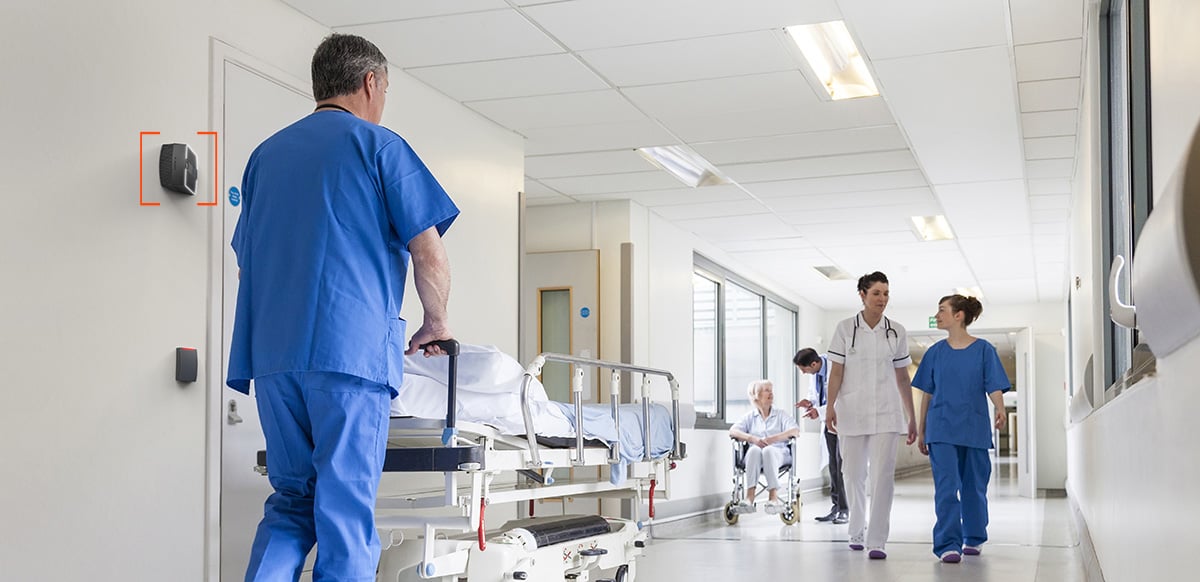The use of biometrics to increase the security integrity of hospital settings has been booming, and it is only expected to rise. According to recent research studies, the global healthcare biometrics market is projected to reach $14.5 billion by 2025.

Types of Biometric Security
Facial Authentication
There are a variety of options for healthcare facilities to implement biometric security in their organizations to increase hospital access controls. A few examples of which include facial authentication, fingerprint reads, and retina scans. Each of these increases security protocol, without the risk of employee badges being lost, stolen, or borrowed.
Facial authentication technology creates a 3D map of an individual’s face, using this as their control. Once their picture is converted into binary via the proprietary algorithm, it is discarded. There is no way to find or reconstruct the image after the conversion process. The binary code is the only information associated with the user. When that same staff member is attempting to access a controlled area, their face is scanned using 2D and 3D scanning. At that point, the software determines if there is a match and if access should be granted. This offers a touchless, frictionless approach to using biometrics in healthcare facilities.
Some facial authentication tools also offer tailgating protection. Tailgating is when an unauthorized person follows an approved person into a controlled area, with or without their knowledge. When this occurs, these tools will notify the appropriate staff member of the potential security breach.
Fingerprint Scans
Some healthcare facilities are using fingerprint scanners for hospital access control as well. Like other biometric scanning options, the risk of compromise is quite low with fingerprint reads, as biometric data cannot be lost, stolen, or shared. Unlike facial recognition, fingerprint scanning is not a hands-free approach and causes friction for staff members.
Retina Scans
Retina scans is another form of biometrics in healthcare. By using a low-level infrared light, an individual's blood vessel patterns are mapped out, becoming the control image. When an employee attempts to access a controlled area their retinas are scanned to verify the blood vessel mapping matches that of the control, verifying they are indeed an approved staff member. Unlike facial authentication, retina scanning does not offer tailgating protection.
The Choice is Clear
While there are many different types of biometrics, only facial authentication provides a non-intrusive experience while positively validating the identity of authorized individuals. The ease of use combined with the level of security provided by facial authentication makes this type of biometric security platform one of the most cutting edge and secure methods on the market.
Why Are Biometrics the Future in Healthcare Center Security?
Biometric security tools have continued to advance in sophistication, accuracy, and reliability over the last decade. Although there are other methods of hospital access controls, like proximity cards or passcodes, these methods are far less secure than biometrics. Proximity cards, access badges, and fobs can all be lost, stolen, or shared. Similar risks are posed with passwords, passcodes, or pins. Furthermore, when employees are asked to remember yet another passcode, they often reuse it in other places, decreasing its integrity.
To increase security and heighten access control, biometrics are beginning to replace some of these more archaic forms of security control because of their increased reliability, and inability to be shared, lost, or stolen.
Multi-Factor Authentication
While some hospitals are completely replacing the more traditional methods of access control with biometric screening options, others are choosing to add biometrics in healthcare facilities as another layer of security. Therefore, employees may still need to swipe their proximity cards, and also verify their identity using a biometrics security tool.
By choosing to utilize both, the risk of non-biometric credentials being lost, stolen, or shared is eliminated. This is because they would be using fingerprints, blood vessel mapping, or facial authentication in conjunction with more traditional security tools.
The Importance of Security
It is an obvious fact that the work done at hospitals is incredibly important. Whether it is keeping patient files secure, or ensuring that medications are accessed by only the professionals that can prescribe them, there are several areas of security that cannot be compromised. Patient files possess not only the patient’s medical history, but all of their personally identifiable information, insurance information, contact information, and more.
As the healthcare provider of choice, it is important to take hospital access seriously. A gap in security is a gap in patient care.
Variety of Uses, One Common Goal
Ultimately, there are a variety of ways to utilize biometrics in healthcare. Be it replacing existing security infrastructures, adding to the current security stack to make it a multi-layered approach, or for patient verification.
If a full security replacement is done, hospital administrators can rest easy knowing only the pre-authorized individuals will be accessing controlled areas using biometric data. If biometric controls are put in place in conjunction with current hospital access measures, the same administration will know the previous risks associated with lost or stolen identification cards are now eliminated. This not only increases the integrity of the security systems in place but promotes better patient care and experience.
All of these factors are causing a boom in the utilization of biometrics in healthcare, and the frequency of use will only continue to rise.
Listen to The Hospital of the Future webinar, featuring MLK Hospital, now.
← Previous -- Next →
Tag(s):
Blog
Other posts you might be interested in
View All Posts
Press Release
4 min read
| September 1, 2022
Alcatraz AI Showcases Autonomous Access Control Solutions for Touchless Identity Authentication at GSX 2022
Read More
Blog
5 min read
| February 1, 2022
Optimize Security During COVID-19 and Beyond
Read More
Press Release
3 min read
| October 5, 2020
Alcatraz Sponsors PSA Security Network’s ADAPT 2020 Virtual Event
Read MoreSubscribe to email updates
Additional content around the benefits of subscribing to this blog feed.


